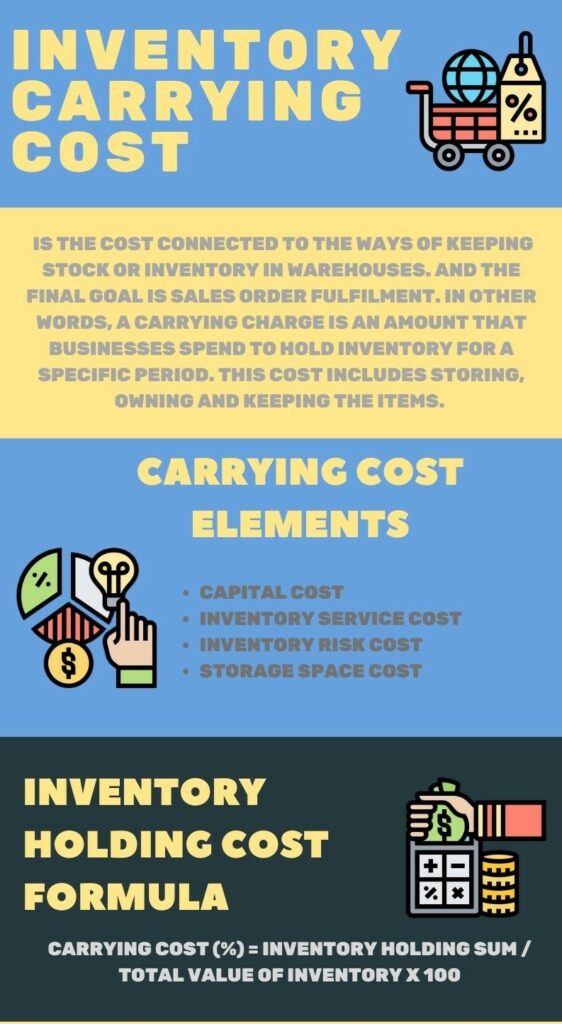One of the significant points of consideration in the stock management system is the inventory carrying cost. We also know it as inventory holding cost. Let us define the inventory carrying cost meaning and give the definition. It is the cost connected to the ways of keeping stock or inventory in warehouses. And the final goal is sales order fulfilment. In other words, a carrying charge is an amount that businesses spend to hold inventory for a specific period. This cost includes storing, owning and keeping the items.

The Importance of the Carrying Cost
Carrying cost is not only one component itself. There is also, for example, warehouse rent cost, operation cost, salaries, some possible inventory losses, insurance cost included. Carrying costs usually reach from 15%-30% of the inventory value. This number is quite relevant and necessary. It shows businesses the allowed period for how long they can keep their inventory.
After this, if there are holding items impossible to sell on time, the company will start losing money. In addition, it helps to understand how much inventory we should sell or buy. Thus we’ll see if the business has suitable levels of stock. Carrying cost and ordering cost calculations and its optimization will definitely help a company get more money and thus increase profit margins.
Let’s overview some main points why any business needs to have consistent, accurate data about its carrying costs?
- It is a crucial metric to figure out the amount of awaited profit from the current inventory.
- Inventory carrying cost helps to determine whether there is a need to increase or decrease production. It is aimed at understanding how to maintain the balance between income and expenses.
- As mentioned above, the carrying costs are usually 15-30 per cent of a company’s inventory value. It is undoubtedly a notable percentage. Thus, it makes this cost an essential accounting factor.
Carrying Cost Elements
Carrying cost includes 4 main components. Let’s see them apart and discuss each separately.
- Capital cost
- Inventory service cost
- Inventory risk cost
- Storage space cost
Capital Cost
Capital cost is the first and the most significant carrying cost element. It is all about the added interests costs of inventory invested money. Capital cost is shown in percentage. It is counted from the total inventory value.
Capital Cost Example:
a company capital cost – 30% of the total inventory costs,
the total inventory = 8,000USD
the company’s capital cost = 2,400USD
Inventory Service Cost
When speaking about inventory service cost, we mean applications, hardware, insurance and taxes. Business insurance costs depend on the product types and their levels. The inventory level is the amount of on-hand inventory kept for order fulfilment. If a company has a high level of stock, it becomes easier to meet the customer demand. But additionally, when ensuring high levels of inventory, businesses also get higher insurance costs and taxes. This, in its turn, raises the price of your total inventory service.
Inventory Risk Cost
Every business component contains risks. And carrying inventory does as well. Inventory risk costs come as inventory shrinkage, product loss, theft, or administrative errors. Such administrative mistakes can happen as misplaced goods, shipping errors, late system updates, etc. Product value depletion is also a risk factor. When warehouses keep items for a very long time, the value of items drops and the price as well.
Storage Space Cost
This type of cost includes the rent for product warehousing. Besides, it also provides air conditioning, heating, lighting, transportation. All those costs relate to the physical warehouses. The costs combine both fixed and variable components for them. For instance, the rent cost is fixed. In contrast, the material handling cost is unstable because it is based on demand and the number of stocked items.

How to Calculate the Inventory Carrying Cost?
As we have already understood, we express the inventory holding cost in per cent. This calculation is vital for understanding the company profit made from the inventory. Thus, to calculate the carrying cost, we should divide the inventory holding amount by the total value of the stock, then multiply by 100. Accordingly, the Inventory Holding Cost Formula is the following:
Carrying cost (%) = Inventory holding sum / Total value of inventory x 100
We would like to mention that there is a variety of inventory carrying cost calculators for more precise data. Now let’s come to a step-to-step description of calculating the carrying cost:
1. Calculate the values separately for all inventory cost elements: service cost, risk cost, capital cost, and storage cost.
2. Get the inventory holding sum by adding the components.
3. Find out the total inventory value.
4. Use the final cost of holding the inventory formula and get your result.
Carrying Cost Example: Cycle retailer carrying the inventory for all the models.
The total inventory value = 50,000USD.
Inventory holding sum = 10,000USD.
Inventory carrying cost (%)= 10,000 / 50,000 x 100 = 0.2 x = 20%
What is the Inventory Holding Sum?
The inventory holding sum is the combination of all 4 carrying cost elements. So the formula for the Inventory Holding Sum is:
Inventory holding sum = Inventory service cost + Inventory risk cost + Capital cost + Storage cost
Therefore, to conclude, we’d say that carrying cost gives a chance to determine the profit viewed in contrast to the inventory held. This cost makes sure that you don’t run into losses. At the same time, it is a significant way of internal inventory control that takes responsibility over the periods to hold inventory over.
eSwap is one of the top platforms that helps to keep track of orders. It also gives the high-quality management of items and inventory. It also helps a lot in getting all the metrics, including the inventory carrying cost in its place.







